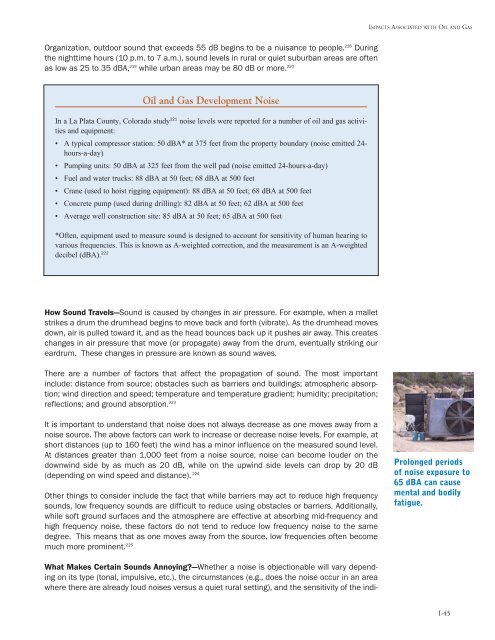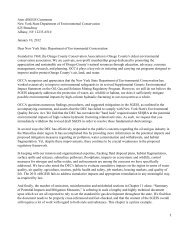Oil and Gas at Your Door? (2005 Edition) - Earthworks
Oil and Gas at Your Door? (2005 Edition) - Earthworks
Oil and Gas at Your Door? (2005 Edition) - Earthworks
You also want an ePaper? Increase the reach of your titles
YUMPU automatically turns print PDFs into web optimized ePapers that Google loves.
IMPACTS ASSOCIATED WITH OIL AND GAS<br />
Organiz<strong>at</strong>ion, outdoor sound th<strong>at</strong> exceeds 55 dB begins to be a nuisance to people. 218 During<br />
the nighttime hours (10 p.m. to 7 a.m.), sound levels in rural or quiet suburban areas are often<br />
as low as 25 to 35 dBA, 219 while urban areas may be 80 dB or more. 220<br />
<strong>Oil</strong> <strong>and</strong> <strong>Gas</strong> Development Noise<br />
In a La Pl<strong>at</strong>a County, Colorado study 221 noise levels were reported for a number of oil <strong>and</strong> gas activities<br />
<strong>and</strong> equipment:<br />
• A typical compressor st<strong>at</strong>ion: 50 dBA* <strong>at</strong> 375 feet from the property boundary (noise emitted 24-<br />
hours-a-day)<br />
• Pumping units: 50 dBA <strong>at</strong> 325 feet from the well pad (noise emitted 24-hours-a-day)<br />
• Fuel <strong>and</strong> w<strong>at</strong>er trucks: 88 dBA <strong>at</strong> 50 feet; 68 dBA <strong>at</strong> 500 feet<br />
• Crane (used to hoist rigging equipment): 88 dBA <strong>at</strong> 50 feet; 68 dBA <strong>at</strong> 500 feet<br />
• Concrete pump (used during drilling): 82 dBA <strong>at</strong> 50 feet; 62 dBA <strong>at</strong> 500 feet<br />
• Average well construction site: 85 dBA <strong>at</strong> 50 feet; 65 dBA <strong>at</strong> 500 feet<br />
*Often, equipment used to measure sound is designed to account for sensitivity of human hearing to<br />
various frequencies. This is known as A-weighted correction, <strong>and</strong> the measurement is an A-weighted<br />
decibel (dBA). 222<br />
How Sound Travels—Sound is caused by changes in air pressure. For example, when a mallet<br />
strikes a drum the drumhead begins to move back <strong>and</strong> forth (vibr<strong>at</strong>e). As the drumhead moves<br />
down, air is pulled toward it, <strong>and</strong> as the head bounces back up it pushes air away. This cre<strong>at</strong>es<br />
changes in air pressure th<strong>at</strong> move (or propag<strong>at</strong>e) away from the drum, eventually striking our<br />
eardrum. These changes in pressure are known as sound waves.<br />
There are a number of factors th<strong>at</strong> affect the propag<strong>at</strong>ion of sound. The most important<br />
include: distance from source; obstacles such as barriers <strong>and</strong> buildings; <strong>at</strong>mospheric absorption;<br />
wind direction <strong>and</strong> speed; temper<strong>at</strong>ure <strong>and</strong> temper<strong>at</strong>ure gradient; humidity; precipit<strong>at</strong>ion;<br />
reflections; <strong>and</strong> ground absorption. 223<br />
It is important to underst<strong>and</strong> th<strong>at</strong> noise does not always decrease as one moves away from a<br />
noise source. The above factors can work to increase or decrease noise levels. For example, <strong>at</strong><br />
short distances (up to 160 feet) the wind has a minor influence on the measured sound level.<br />
At distances gre<strong>at</strong>er than 1,000 feet from a noise source, noise can become louder on the<br />
downwind side by as much as 20 dB, while on the upwind side levels can drop by 20 dB<br />
(depending on wind speed <strong>and</strong> distance). 224<br />
Other things to consider include the fact th<strong>at</strong> while barriers may act to reduce high frequency<br />
sounds, low frequency sounds are difficult to reduce using obstacles or barriers. Additionally,<br />
while soft ground surfaces <strong>and</strong> the <strong>at</strong>mosphere are effective <strong>at</strong> absorbing mid-frequency <strong>and</strong><br />
high frequency noise, these factors do not tend to reduce low frequency noise to the same<br />
degree. This means th<strong>at</strong> as one moves away from the source, low frequencies often become<br />
much more prominent. 225<br />
Prolonged periods<br />
of noise exposure to<br />
65 dBA can cause<br />
mental <strong>and</strong> bodily<br />
f<strong>at</strong>igue.<br />
Wh<strong>at</strong> Makes Certain Sounds Annoying?—Whether a noise is objectionable will vary depending<br />
on its type (tonal, impulsive, etc.), the circumstances (e.g., does the noise occur in an area<br />
where there are already loud noises versus a quiet rural setting), <strong>and</strong> the sensitivity of the indi-<br />
I-45




